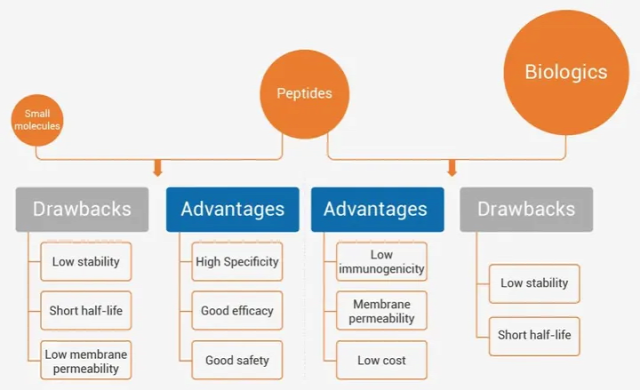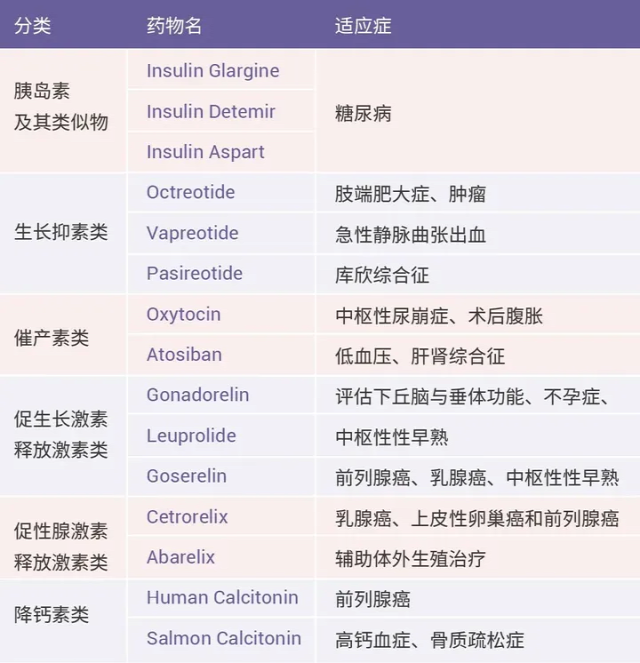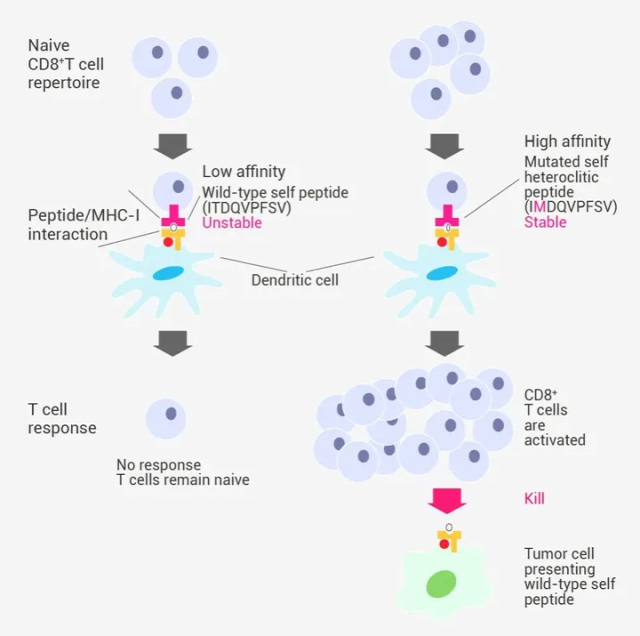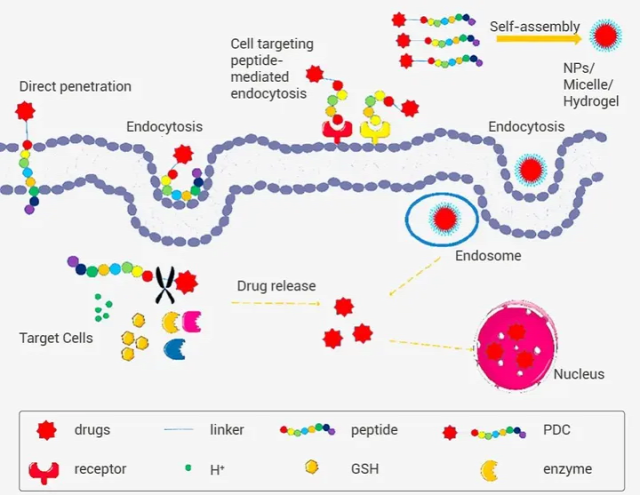Peptides hold a unique position in the field of drug development, and since the emergence of therapeutic insulin in 1922, peptides have played an important role in medical practice. So far, more than one hundred polypeptide drugs have been approved for marketing in the world, and are widely used in the treatment of diabetes, tumor, chronic pain, multiple sclerosis and other diseases. Previously, we have introduced the origin and development of peptides and peptide drugs, and explained the classification and screening of peptide drugs (see previous tweets: Peptides – Unique Drugs).
Today, let’s have a hardcore science popularization on peptide drugs!
1.Peptides, what are their advantages?
Peptides are molecules composed of amino acids as the basic unit, with a molecular weight generally below 10 KDa, between small chemical molecules and biological products. Their main characteristics are high selectivity and low concentration of action. Classic therapeutic peptides such as hormones, growth factors, ion channel ligands, etc. trigger intracellular effects by binding to receptors.
Compared with biological agents such as antibodies and therapeutic proteins, peptides have a similar mode of action, but their immunogenicity is lower. Additionally, due to their ability to be chemically synthesized, their production cost is also lower.
Compared with small molecule drugs, peptides have a larger molecular weight and can more effectively inhibit protein-protein interactions (PPI), with higher selectivity and specificity, lower concentration of action, and lower side effects (Figure 1) [1] [2].

2.What are peptide drugs available?
2.1 Hormonal peptides and their derivative drugs
Generally speaking, there are four main medicinal peptides in clinical practice, one of which is hormone peptides and their derivatives. Due to the short half-life and high synthesis cost of peptides, early peptide drug development mainly focused on the field of low concentration human hormone peptides. The research on peptide drugs began with insulin, followed by the emergence of short peptide drugs such as oxytocin, antidiuretic hormone, somatostatin, and gonadotropin-releasing hormone, which opened up and enriched this field (Table 1). Many hormone drugs are still in use today.
With continuous scientific research, people have improved the characteristics of peptide hormones through chemical modifications such as C-terminal amidation, D-type amino acids, cyclization, and conjugation of long-chain fatty hydrocarbons.
For example, Octreotide and Pasireotide, which are based on somatostatin β Transforming the pharmacophore for modification successfully extended its half-life. In addition, drug development can also be based on the development of agonists or antagonists related to peptide hormones, such as Goserelin and Cetrorelix [3].
Table 1 Partial hormone peptides and their derivative drugs [3]

2.2 Natural Peptide Products
In addition to human derived peptides, there are also natural peptide products from plants, microorganisms, and other sources. Typical natural active peptides mainly include secondary metabolites of microorganisms and active peptides isolated from amphibian and insect venom. ICK peptides are a classic class of venom peptides, whose disulfide bond structure provides them with extraordinary stability and resistance to proteases, making them suitable as drug leads [3]. Ziconotide is an ICK peptide derived from toxic cone-shaped snails, which has good analgesic effects (Figure 2) [4].

2.3 Peptide vaccines
Of course, there is also a peptide vaccine that must be mentioned. It is a subunit vaccine made from peptides, which can act as an immunogen to stimulate the body to produce an immune response by simulating the epitope sequence of antigens. Multimeric001, a representative type of anti infective peptide vaccine, contains epitopes of influenza virus B, T helper cells, and cytotoxic T cells, which can prevent various types of A and B influenza viruses. It has entered clinical stage III [5].
Compared with traditional inactivated and attenuated vaccines, polypeptide vaccines can not only be used as preventive vaccines against infectious or non infectious diseases, but also be used to treat Alzheimer’s disease, malignant tumors and other diseases [6]. Disomotide (G209-2M, IMDQVPFSV) is a melanoma antigen developed based on Gp100:209-217 (ITDQVPFSV), which can promote the production of cytotoxic T lymphocytes (CTL), recognize natural G209 and melanoma cells, and is currently in phase III clinical trials (Figure 3) [7] [8].

The antigenic peptide IMDQVPFSV (Disaotide) that binds to the natural epitope ITDQVPFSV after point mutation exhibits stronger immunogenicity.
2.4 PDC peptide drugs
In addition, peptide drug delivery systems primarily based on PDC are also one of the directions of clinical research. Due to its excellent biological activity, non toxicity, and good compatibility, peptides can be used as drug carriers for peptide drug conjugates (PDC). At present, 177 Lu dotata (lutathera) ®) It has been approved by the FDA for the treatment of neuroendocrine tumors, and there are still many PDCs currently in the clinical or preclinical stage. PDC is composed of peptides covalently bound to drugs through ligands, retaining the peptide’s function and biological activity. At the same time, it also utilizes the cleavability of the ligands to release drugs in a responsive manner, thereby improving drug circulation stability and targeting in vivo, and reducing drug toxicity and side effects (Figure 4) [9].

3.Summary
This issue introduces the characteristics of peptide drugs and four main types of medicinal peptides, and combines specific cases to further deepen our understanding of peptide drugs. At present, peptide drugs have been in clinical practice for a century, and classic hormone drugs still dominate the main market. The two major bottlenecks of inconvenient delivery methods and frequent delivery cycles still need to be solved urgently. The constantly emerging new technologies such as PDC and multifunctional peptides also need to be explored and enriched by friends~
The advantage of the KS-V Peptide integration service platform is to launch a catalog of peptide products with scientific research value. Each peptide product is purified by HPLC, resulting in more stable quality and timely delivery. The application scenarios cover new hotspots and valuable research fields, such as protein purification and detection, disease-related research, immunology and biochemistry research, scientific research peptides, medicinal peptides, etc., to meet the needs of researchers at different stages. We have a complete customer service system and technical team, enjoying a one-on-one specialized service experience, and providing you with professional services in a timely manner.
Peptides hold a unique position in the field of drug development, and since the emergence of therapeutic insulin in 1922, peptides have played an important role in medical practice. So far, more than one hundred polypeptide drugs have been approved for marketing in the world, and are widely used in the treatment of diabetes, tumor, chronic pain, multiple sclerosis and other diseases. Previously, we have introduced the origin and development of peptides and peptide drugs, and explained the classification and screening of peptide drugs (see previous tweets: Peptides – Unique Drugs).
Today, let’s have a hardcore science popularization on peptide drugs!
1.Peptides, what are their advantages?
Peptides are molecules composed of amino acids as the basic unit, with a molecular weight generally below 10 KDa, between small chemical molecules and biological products. Their main characteristics are high selectivity and low concentration of action. Classic therapeutic peptides such as hormones, growth factors, ion channel ligands, etc. trigger intracellular effects by binding to receptors.
Compared with biological agents such as antibodies and therapeutic proteins, peptides have a similar mode of action, but their immunogenicity is lower. Additionally, due to their ability to be chemically synthesized, their production cost is also lower.
Compared with small molecule drugs, peptides have a larger molecular weight and can more effectively inhibit protein-protein interactions (PPI), with higher selectivity and specificity, lower concentration of action, and lower side effects (Figure 1) [1] [2].

2.What are peptide drugs available?
2.1 Hormonal peptides and their derivative drugs
Generally speaking, there are four main medicinal peptides in clinical practice, one of which is hormone peptides and their derivatives. Due to the short half-life and high synthesis cost of peptides, early peptide drug development mainly focused on the field of low concentration human hormone peptides. The research on peptide drugs began with insulin, followed by the emergence of short peptide drugs such as oxytocin, antidiuretic hormone, somatostatin, and gonadotropin-releasing hormone, which opened up and enriched this field (Table 1). Many hormone drugs are still in use today.
With continuous scientific research, people have improved the characteristics of peptide hormones through chemical modifications such as C-terminal amidation, D-type amino acids, cyclization, and conjugation of long-chain fatty hydrocarbons.
For example, Octreotide and Pasireotide, which are based on somatostatin β Transforming the pharmacophore for modification successfully extended its half-life. In addition, drug development can also be based on the development of agonists or antagonists related to peptide hormones, such as Goserelin and Cetrorelix [3].
Table 1 Partial hormone peptides and their derivative drugs [3]

2.2 Natural Peptide Products
In addition to human derived peptides, there are also natural peptide products from plants, microorganisms, and other sources. Typical natural active peptides mainly include secondary metabolites of microorganisms and active peptides isolated from amphibian and insect venom. ICK peptides are a classic class of venom peptides, whose disulfide bond structure provides them with extraordinary stability and resistance to proteases, making them suitable as drug leads [3]. Ziconotide is an ICK peptide derived from toxic cone-shaped snails, which has good analgesic effects (Figure 2) [4].

2.3 Peptide vaccines
Of course, there is also a peptide vaccine that must be mentioned. It is a subunit vaccine made from peptides, which can act as an immunogen to stimulate the body to produce an immune response by simulating the epitope sequence of antigens. Multimeric001, a representative type of anti infective peptide vaccine, contains epitopes of influenza virus B, T helper cells, and cytotoxic T cells, which can prevent various types of A and B influenza viruses. It has entered clinical stage III [5].
Compared with traditional inactivated and attenuated vaccines, polypeptide vaccines can not only be used as preventive vaccines against infectious or non infectious diseases, but also be used to treat Alzheimer’s disease, malignant tumors and other diseases [6]. Disomotide (G209-2M, IMDQVPFSV) is a melanoma antigen developed based on Gp100:209-217 (ITDQVPFSV), which can promote the production of cytotoxic T lymphocytes (CTL), recognize natural G209 and melanoma cells, and is currently in phase III clinical trials (Figure 3) [7] [8].

The antigenic peptide IMDQVPFSV (Disaotide) that binds to the natural epitope ITDQVPFSV after point mutation exhibits stronger immunogenicity.
2.4 PDC peptide drugs
In addition, peptide drug delivery systems primarily based on PDC are also one of the directions of clinical research. Due to its excellent biological activity, non toxicity, and good compatibility, peptides can be used as drug carriers for peptide drug conjugates (PDC). At present, 177 Lu dotata (lutathera) ®) It has been approved by the FDA for the treatment of neuroendocrine tumors, and there are still many PDCs currently in the clinical or preclinical stage. PDC is composed of peptides covalently bound to drugs through ligands, retaining the peptide’s function and biological activity. At the same time, it also utilizes the cleavability of the ligands to release drugs in a responsive manner, thereby improving drug circulation stability and targeting in vivo, and reducing drug toxicity and side effects (Figure 4) [9].

3.Summary
This issue introduces the characteristics of peptide drugs and four main types of medicinal peptides, and combines specific cases to further deepen our understanding of peptide drugs. At present, peptide drugs have been in clinical practice for a century, and classic hormone drugs still dominate the main market. The two major bottlenecks of inconvenient delivery methods and frequent delivery cycles still need to be solved urgently. The constantly emerging new technologies such as PDC and multifunctional peptides also need to be explored and enriched by friends~
The advantage of the KS-V Peptide integration service platform is to launch a catalog of peptide products with scientific research value. Each peptide product is purified by HPLC, resulting in more stable quality and timely delivery. The application scenarios cover new hotspots and valuable research fields, such as protein purification and detection, disease-related research, immunology and biochemistry research, scientific research peptides, medicinal peptides, etc., to meet the needs of researchers at different stages. We have a complete customer service system and technical team, enjoying a one-on-one specialized service experience, and providing you with professional services in a timely manner.

